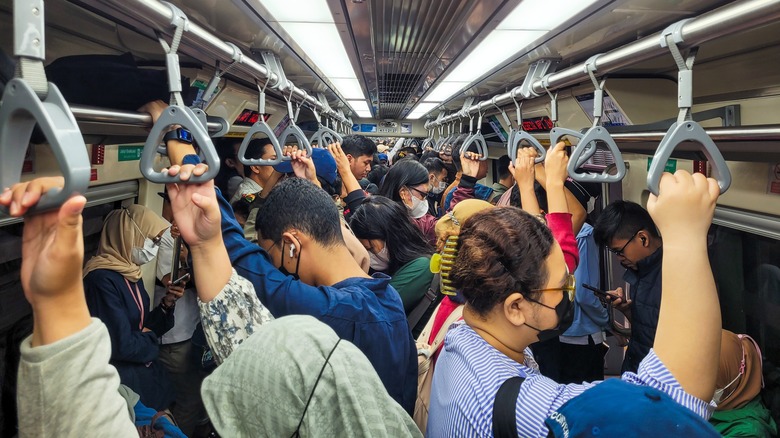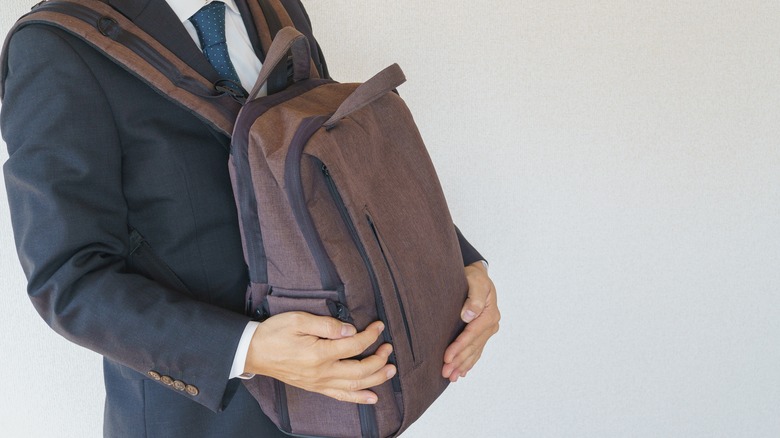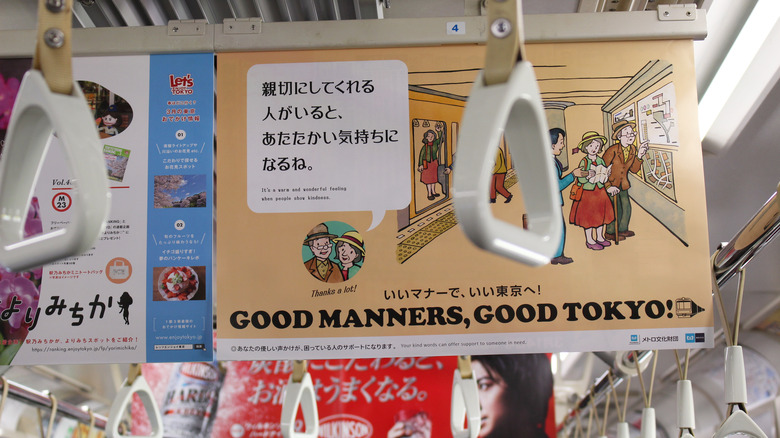This Unspoken Train Etiquette Rule Is Crucial For Tourists To Know Before Visiting Japan
Before visiting Japan, it might be good to brush up on your train manners, especially if you plan on traveling around big cities with a backpack. Some stations may have posters on the wall encouraging the preferred etiquette, which includes wearing your backpack in front while riding the train. In one such poster from the Tokyo Metropolitan Bureau of Transportation, the subject of Johannes Vermeer's famous painting, "Girl with a Pearl Earring," could be seen with a backpack slung across her chest on a packed commuter train. The cartoon kid behind her had his bag on his back like normal, but he was bumping up against her, and he and the other surrounding passengers looked distressed. "Please mind your backpack for other passengers when crowded," the poster read.
The reactions that poster depicted might seem like an exaggeration, not to mention counterintuitive. After all, backpacks are meant for the back, aren't they? What's the big deal about wearing them on the train? However, it's worth remembering that you're dealing with different cultural norms while in a shared space — one that can be particularly tight during rush hour. In 2019, people's "manner of placing or holding bags" ranked as the most annoying behavior type in the Japan Private Railway Association's annual survey on train and station manners (via Nippon.com). Among the "most annoying behaviors related to carrying or placement of bags," the biggest offender by a wide margin was "backpacks, shoulder bags, and other bags worn on the shoulder or back."
Why train passengers wear their backpack in front
In Japanese train stations, even if you don't see a poster about wearing your backpack in front, you might see people observing that custom as an unwritten rule. This could be because they've had years to absorb such poster images as part of an organized effort to promote good train manners. An official for the Odakyu Electric Railway Co. told The Japan Times it had been putting up posters about backpacks since 2005, in part because they've been known to get snagged in the automatic train doors, leading to delays. "We are asking passengers for their cooperation so that everyone can use our trains in a pleasant manner," the official said. "We feel there have been fewer incidents after putting up posters and having station attendants and conductors make announcements asking passengers to hold their bags in front."
Some train and subway lines, like the Tozai Line in Tokyo, get so crowded that you could even see white-gloved pushers (called oshiya in Japanese) working to cram everyone in and get the doors closed. During rush hour, when commuters are bunched together like sardines in a can, people will squeeze between the two lines of handrail holders who are standing alongside the seats in each car. If you're one of those handrail holders, and you've got a bag bulging off your back, it could not only disturb them; it could also invite pickpockets. That's when it's good to use the overhead baggage rack.
Other important forms of train etiquette
The backpacks-in-front rule isn't limited to trains in Tokyo. In Kansai — one of the best regions to view cherry blossoms in Japan — train lines like the Hanshin Electric Railway and Keihan Electric Railway have also featured posters showing how backpacks can be a nuisance to others. When you're in Japan's most budget-friendly city, Osaka, another thing to remember while entering or exiting the train platform is that people usually stand on the right of the escalator, leaving the left lane open. (It's done the opposite way virtually everywhere else.)
In 2018, Tokyo Metro, which operates the capital's subway system, began targeting foreign visitors with English train etiquette posters. Since 1974, it's been offering friendly reminders about other forms of etiquette like stepping aside (or briefly stepping off the train) to make way for passengers disembarking. One of its earliest public service announcements in 1976 even warned against manspreading, sitting with your legs wide apart. That's not as much of a concern if you're riding in this special type of train car for women in Japan.
Talking loudly, listening to loud music through one's headphones, and not giving up priority seats to those who need them (like pregnant women or disabled people) are some other things that are considered bad train manners here. In a collectivist culture like Japan's, group harmony often outweighs the preferences of the individual. Just keep that in mind when you're on the train with your backpack, surrounded by other passengers.


